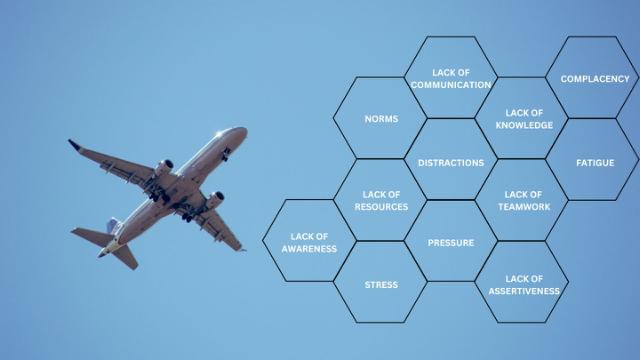
Diving into the Dirty Dozen: Limit the Impact and Improve Safety
Have you heard of 12 factors which affect human performance and safety? If you are an aviation professional, odds are that you have. But do you know how to counter the effects and create a resistant and safe environment?
Aviation is a high-pressure and high-stakes industry. Therefore, it is paramount to understand the factors which influence human performance and safety.
In fact, 12 ferocious factors – known as the Dirty Dozen – have great impact on decision-making and actions in the operational environment.
The question is: What can you do to raise awareness and proactively address these potential ticking time bombs? Before ‘Dirty’ turns ‘Fatal’...
What’s With the Dozen?
The 12 factors provide a comprehensive framework for understanding and navigating the challenges that aviation professionals face in the operational environment. Every day.

Here is an overview of each factor and the impact they can have on decision-making, actions, and – perhaps most importantly – safety:
- Lack of communication might lead to wrong instructions or human error which can escalate to critical situations.
- Lack of knowledge can cause the pilot or staff to make wrong decisions in a desperate attempt to fill the gap without thinking about the consequences.
- Complacency or over-confidence can cause pilots or maintenance staff to disregard established procedures and practices, potentially resulting in accidents.
- Norms are subject to deviations which sanction potentially dangerous behaviours as standard practice, thus increasing the likelihood of accidents.
- Distractions can come from many sources such as loud noises, electronic devices, or collegial conversations and may result in lack of attention to safety.
- Lack of teamwork can result in misunderstandings between colleagues, leading to misjudgements and wrong decisions in the operational environment.
- Fatigue is a critical cause of human error since pilots, crew, or maintenance staff are more prone to making poor decisions or even errors which could jeopardise safety.
- Lack of resources may force pilots or maintenance staff to compensate for faulty equipment, lack of staff or the like. This could cause them to cut corners and increases pressure in the operational environment.
- Pressure is a condition in a high-risk environment, increasing the risk of human errors if the pilot, crew member or mechanic is not trained to address and counteract external and internal pressure.
- Lack of assertiveness means that crew or staff of lower rank often fail to speak up in critical situations, leaving safety concerns unaddressed.
- Lack of awareness in critical situations can lead to human error and safety-related incidents.
- Stress is a consequence of high-pressure situations, but lack of stress management can lead to poor decision-making, putting passengers and colleagues in danger.
MAYDAY, MAYDAY!
Recognising and addressing these 12 factors is a step in the right direction to enhance safety and minimise errors. But how can you go about the Dirty Dozen?
Essentially, training in Crew Resource Management and Human Factors are crucial to ensuring the necessary knowledge and skills to counteract the effects of the Dirty Dozen in the operational environment.
The MAYDAY Active Learning Tools are a collection of interactive and learner-centred training tools which enhance non-technical skills such as communication, teamwork, leadership, and decision-making. In other words, the MAYDAY tools enable pilots, cabin crew, and maintenance staff to mitigate the impacts of the Dirty Dozen.
In the air and on the ground.
Explore a world of interactive training here.
Explore Our World of Active Learning
Get acquainted with MAYDAY - an interactive training solution for the global aviation industry.




